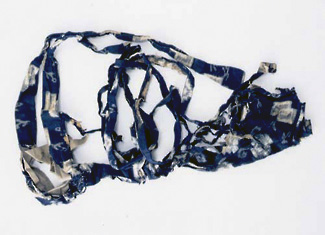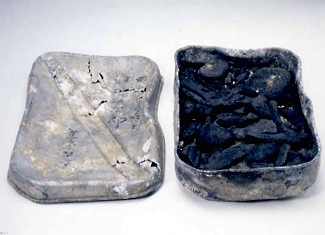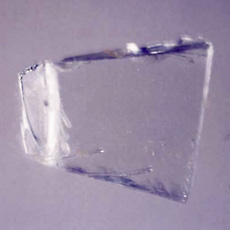Community Volunteer Citizen Corps
Community Volunteer Citizen Corps were formed by each municipality, and their heads served as the commanders. In Hiroshima City, a battalion was formed in each Neighborhood Association Alliance, and a company in each neighborhood association. Platoons were formed as sub-units, and squads were formed under them. In August 1945, based on the marching orders from the Hiroshima Prefecture Volunteer Citizen Corps headquarters, many Community Volunteer Citizen Corps members were mobilized for the Hiroshima City 6th Building Demolition Works. On August 6, approximately 30,000 individuals of 29 of 33 Community Volunteer Citizen Corps Battalions in Hiroshima City and approximately 10,000 Community Volunteer Citizen Corps members from outside the city were mobilized for building demolition works.

Monpe trousers
Yoshiko Otoi (then, 28), who was mobilized as a community volunteer citizen corps member, was exposed to the bomb at her building demolition worksite in Zakoba-cho (now, Kokutaiji-machi, Naka-ku) approximately 1 km from the hypocenter, and sustained burn injuries. After returning to her home in Ujina-kanda, she was accommodated in the relief station on the Ninoshima Island, but died two days later on August 8.
Donated by Kaneyoshi Otoi
Keepsake—Lunch box
Heijiro Nishimura, who served as the vice president of the neighborhood association in Takajo-machi (now, Honkawa-cho, Naka-ku), led 30 to 40 members of his neighborhood association for building demolition as a community volunteer citizen corps member, and exposed to the bomb when he and his members assembled at the yard of First Hiroshima Prefectural Junior High School (now, Hiroshima Kokutaiji High School), approximately 900 meters from the hypocenter. His wife Itsu also experienced the A-bombing, and they both remain missing. Yaeko, Mr. and Mrs. Nishimura’s daughter (then, 24), who had evacuated to Gion at that time, entered Hiroshima City on the 7th, the following day, and searched for her parents, but could not even find their ashes. Yaeko carefully carried back this lunch box alone. The charred-black contents of the lunch box were vegetables such as burdock roots, potatoes, and beans.
Donated by Hiroji Nishimura


Shard of glass coming out of the body
Shouldering her one-year old son, Yoshie Hatanaka, a three-months pregnant woman (then, 25) was dispatched to Nishi-daiku-machi (now, Eno-machi, Naka-ku), approximately 800 meters from the hypocenter, for building demolition along with other members of her neighborhood association of Funairi-naka-machi as a community volunteer citizen corps member. All she had to do was to be responsible for the lunch boxes of all the members, due to other members’ consideration.
At the moment of the A-bombing, countless shards of glass stuck into the bodies of Yoshie and her son. Yoshie then was caught in the black rain and hovered at death’s door due to symptoms of acute radiation sickness, including hair loss and vomiting. Her son died 23 days after the bombing.
After her recovery, Yoshie gave birth to Yuriko in 1946. Yuriko, who had been exposed to the bomb in the womb, suffered from microcephaly, requiring nursing care even in her daily life. Although Yoshie kept saying that she couldn’t die leaving Yuriko behind, she breathed her last due to cancer in 1978. This shard of glass came out of the back of her left hand, breaking the skin in June 1976, 31 years after the bombing.
Donated by Yoshie Hatanaka
